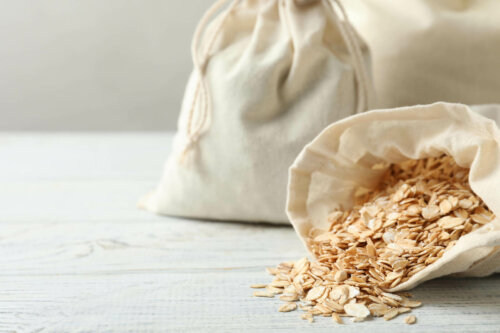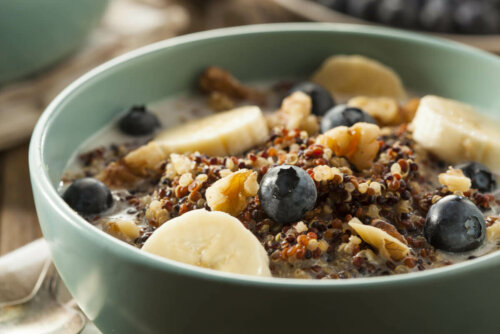Are Breakfast Cereals Healthy or Unhealthy?


Written and verified by the nutritionist Florencia Villafañe
Eating breakfast cereals for breakfast is common in many households. But is this a healthy or unhealthy practice?
Well, it depends.
There are many different ways to enjoy cereal, whether it be with milk, vegetable drinks, or yogurts Also, some are made with corn, while others with rice or oatmeal. Some of them even have a commercial version of chocolate and many other ingredients.
According to some organizations, cereals such as oats, rice, wheat, and corn have a high nutritional value due to their content of proteins, carbohydrates, natural fats, and fiber.
However, these grains lose their nutritional properties once the food industry subjects them to a refining process to box them. In this respect, the specific difference between a whole-grain cereal and a boxed cereal is the manufacturing process.
Types of cereals: The healthy and the unhealthy
Processed breakfast cereals originated in the vegetarian movement of the last quarter of the 19th century. (At least according to the article published in Ministerio de Agricultura, Ganadería y Pesca de Argentina.) Production is quite big nowadays and there’s a wide variety of them.
There are various options of breakfast cereals, such as:
- Flakes are the result of refined flours and contain salt, sugar, malt, and other added ingredients. They’re usually fortified with vitamins and minerals to compensate for it.
- Popped is the result of adding pressurized air to the various grains. These cereals are light and crunchy compared to others.
- Whole-grain and rich in fiber are those made with whole grain.
- Muesli type is a mixture of cereals such as oats, puffed rice, corn, wheat; nuts like almonds, walnuts, hazelnuts, and dried fruits such as raisins, apple, banana, and coconut.
- Porridge is cooked oatmeal and might contain other ingredients.

Find out What To Eat and What To Avoid for a Healthy Breakfast
Is it healthy or unhealthy to eat cereal for breakfast?
Noted that eating cereal for breakfast is only healthy if it’s made from whole grains. In contrast, eating boxed cereals on a regular basis isn’t healthy. In this respect, you must learn to differentiate what each one of these provides.
Whole grain cereals
Cereals from whole grains, such as oats, rye, barley, corn, whole wheat, and brown rice provide vitamins, minerals, and nutrients the body needs. They also contain dietary fiber — which fulfills various functions in the body and is therefore beneficial.
Many other grains aren’t cereals, such as quinoa, amaranth, and buckwheat. These are also quite nutritious.
Boxed cereals
As mentioned above, boxed cereals are usually the result of refined grains. In turn, they have other substances excess that turns them into junk food.
According to scientific evidence, companies make these edible products by:
- Processing the grains with white flour
- Then, adding other ingredients such as sugar, cocoa, and water
- The mixture then undergoes an extrusion process that involves the use of high-temperature through a machine that shapes the cereal
- They dry the dough
- Finally, they mold it into shapes — balls, stars, rings, flakes, or rectangles
As you can see, boxed cereals are highly processed foods that contain too much sugar and contain absolutely no fiber.
The health benefits of eating whole grain cereals for breakfast
These depend on which cereal you eat for breakfast. On the one hand, you can eat whole grains such as oatmeal and on the other, the boxed ones mentioned above.
They can prevent constipation and promote general health
Eating oatmeal, supplemented with fruit and seeds, is a healthy option due to its contribution of vitamins, amino acids, and fiber, which is great for the liver and heart. Also, oats and other grains provide fiber promote intestinal transit, and aid in the prevention of constipation.
They provide vitamins and minerals
Wholegrain cereals provide micronutrients such as vitamin A, folic acid, and minerals such as iron, zinc, selenium, magnesium, and copper. Thus, reinforcing the immune system.
They provide healthy fats and lower bad cholesterol
Grains such as buckwheat and quinoa contain omega-3 essential fatty acids. They also provide protein (which contributes to satiety) and dietary fiber. These components help reduce bad cholesterol, regulate blood glucose and prevent diseases such as diabetes.
They contribute to maintaining a healthy weight
Specifically, a portion of quality food rich in fiber and protein is saying and keeps you from overeating and snacking. For this reason, it’s great for maintaining a healthy weight.
Do you ever wonder if Is it Healthy to Eat Oats for Breakfast?
Boxed cereals: The healthy and the unhealthy

Of course, it’s better to eat wholegrain cereals with minimal processing. Opt for those that don’t contain excess sugars or added chemicals if you must eat the latter.
Thus, make sure your boxed cereals have the following:
- Between 15 and 20 grams of carbohydrates per serving, maximum
- Less than 250 milligrams of sodium
- At least 25% of minerals such as calcium or iron (i.e., fortified)
- At least three grams of fiber
- Up to eight grams of white sugar
- Less than three grams of fat
Read the nutritional labeling in order to choose a quality product. Don’t use it regularly if the first ingredients are sugar, fats or refined oils, and flours.
So, is eating cereal for breakfast healthy or unhealthy?
To determine whether a cereal is healthy or unhealthy, you must be critical and take into account that the occasional intake of processed food, be it a boxed or wholegrain cereal won’t lead to specific health damage. Mainly, it’s the frequency and quantity with which you eat it that matters.
Similarly, keep in mind that you can have a healthy breakfast as long as you opt for natural whole grains such as oatmeal, puffed rice grains (without added sugar), quinoa, and popped amaranth, and granola, among others.
Also, keep in mind that all of the meals of your day should provide quality nutrients. Thus, stick to natural or minimally processed products as much as you can.
So, what do you think? Is your morning cereal healthy or unhealthy?
All cited sources were thoroughly reviewed by our team to ensure their quality, reliability, currency, and validity. The bibliography of this article was considered reliable and of academic or scientific accuracy.
- Whittaker, P., Tufaro, P. R., & Rader, J. I. (2001). Iron and folate in fortified cereals. Journal of the American college of nutrition, 20(3), 247-254.
- Cereales para el desayuno. Alimentos argentinos. Secretaría de Agricultura, Ganadería y Pesca. Disponible en: http://www.alimentosargentinos.gob.ar/contenido/revista/ediciones/49/productos/r49_07_CerealesDesayuno.pdf
- Análisis de producto Cereales para el desayuno. Alimentos Argentinos. Secretaría de Agricultura, Ganadería y Pesca. Disponible en: http://www.alimentosargentinos.gob.ar/contenido/sectores/farinaceos/Productos/CerealesDesayuno_2010_11Nov.pdf
- Cereales de caja: mucha azúcar y pocos nutrientes. El poder del consumidor. Disponible en: https://elpoderdelconsumidor.org/2011/10/mucha-azucar-y-pocos-nutrientes-cereales-de-caja/
- Huamanchumo, W. (2020). Pseudocereales andinos: valor nutritivo y aplicaciones para alimentos libres de gluten.
This text is provided for informational purposes only and does not replace consultation with a professional. If in doubt, consult your specialist.








